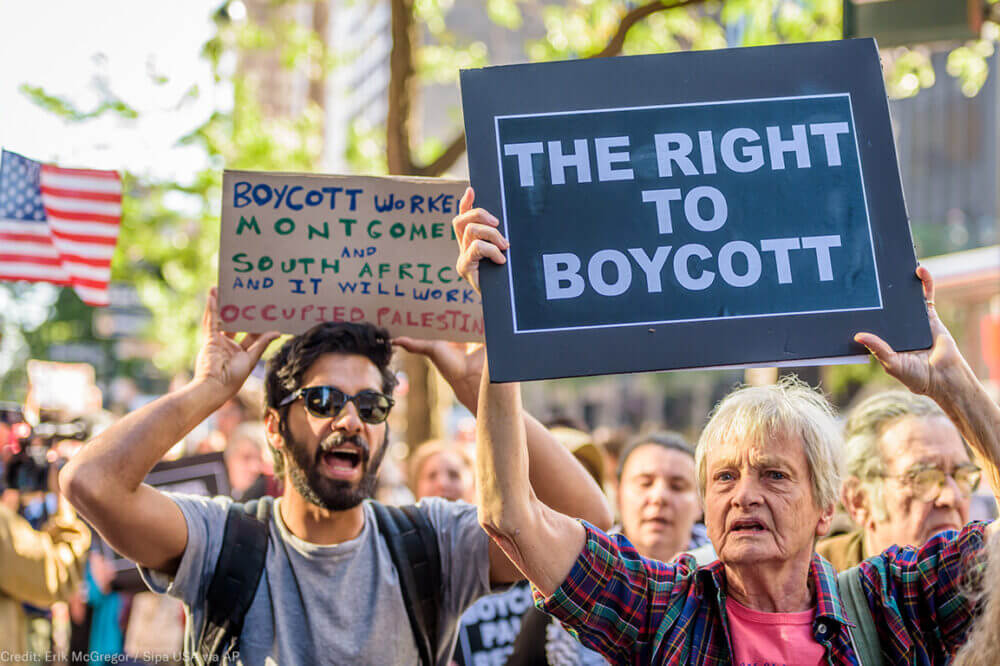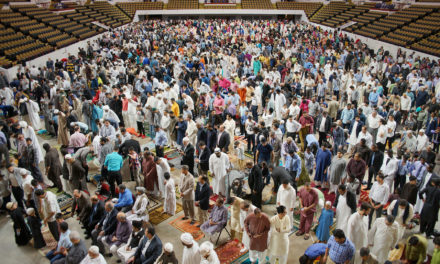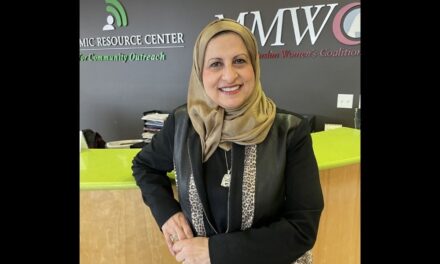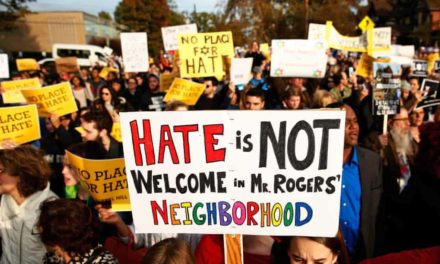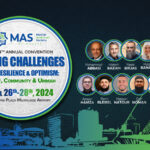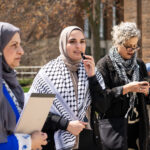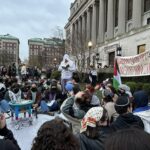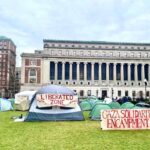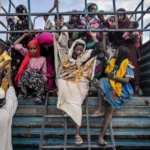PROTEST AGAINST THE ISRAEL ANTI-BOYCOTT ACT, 2019. (PHOTO VIA ACLU)
The repression of Palestinian rights claims is the single most urgent crisis of free speech in the United States today. How we narrate this crisis, and the frameworks we use to analyze organized efforts to silence pro-Palestine speech, shape the strategies through which we resist them. As Gaza burns, the hegemony of anti-Palestine, pro-apartheid zealots seems suffocating – and that’s the point. The history of McCarthyism, as Alex Kane recently noted in Jewish Currents, offers one useful lens: doxxing trucks, rescinded job offers, law-firm blacklists, and the ignominious House censure of Rashida Tlaib all carry the eerie chill of the 1950s Cold War era.
As a historian of censorship, I believe a complementary framework for analyzing the intensifying repression of pro-Palestinian voices can be found in recent censorship campaigns that have resulted in banning LGBTQ books and works of so-called “Critical Race Theory.” It’s firmly established that efforts to ban these texts are motivated by anti-gay sentiment and racism. But rarely is the suppression of Palestinian voices linked to such efforts – yet Islamophobia animates the pro-Israel crusade in strikingly parallel ways; these are deeply interrelated campaigns of political targeting. The only serious difference is that the recent censorship campaigns are aligned with the U.S. political right, whereas anti-Palestinian censorship is a joint project of the Republican and Democratic parties.
A thorough new report released by the Rutgers Law School Center for Security, Race and Rights maps out the role Islamophobia plays in structuring the national discussion of Palestinian rights. In Presumptively Antisemitic: Islamophobic Tropes in the Palestine-Israel Discourse, authors Mitchell Plitnick and Sahar Aziz identify how Palestinian rights claims are laundered by the Israel Lobby and others, through Islamophobic lenses. Self-styled experts imbue such claims – calls for Palestinian human rights, for the consistent application of international law, and the like – with the presumption they are antisemitic to preemptively nullify them. It’s essentially the same “folk devil” basis for moral panic that drives the book bans, with such organizations as AIPAC playing the parallel role to explicitly far-right groups like Moms for Liberty.
When right-wing dark-money groups come for Jonathan Evison’s Lawn Boy or Maia Kobabe’s Gender Queer, they’re extending a legacy dating back to the 1873 Comstock Act, which first put teeth in federal obscenity law. “Obscenity” was always a tool for enforcing sexual normativity. The anti-queer aspects of obscenity were on display when the Supreme Court affirmed the law in the 1957 Roth v. U.S. decision, pinning the legal definition of obscenity to “prurient interest,” defined by the “average person, applying contemporary community standards.” Sex was not inherently obscene, declared the court—but male physique magazines, lesbian pulp novels, queer avant-garde cinema, however, were all targets for obscenity charges. This has been replayed every subsequent decade; a generation ago, it was Heather Has Two Mommies under fire.
The accompanying assault on “Critical Race Theory” is a patently bad-faith effort whose architect, Christopher Rufo, publicly acknowledged that he was devising a new dog whistle the right could use to win political campaigns. Of course, CRT is actually a small body of legal theory rarely assigned to high school or elementary school students, but under Rufo’s guidance, it came to mean anything critical of white supremacy – particularly when penned by Black authors. Rufo’s efforts are worth taking seriously only because their social power forces us to do so – his intellectually-bankrupt campaign simply repackaged previous anti-Black talking points: “welfare queens,” “forced busing,” etc. Yet, it has achieved a number of official bans.
Similar dynamics shape U.S. political discourse around Palestine.
The report takes stock of “Racist tropes that Muslims and Arabs innately hate Jews.” These tropes serve the same foundational role as heteronormative standards for obscenity: setting up foregone conclusions – here, “discrediting the Palestinian people from realizing their full civil, political, national, and human rights” by foreclosing free and open debate on Israel’s well-documented violations of international law that human rights organizations now consider apartheid. Instead, the House of Representatives diverts attention toward Tlaib for sharing the universalist human rights chant, “From the river to the sea…” and reading antisemitism into the terse rhyme where none exists. The message is clear: a Palestinian calling for a one-state solution where people of all faiths and ethnicities have equal rights is anathema that must be falsely depicted as antisemitic. Because the call comes from a prominent Arab and Muslim woman, the media gladly plays along – knowing full well the accusation is baseless.
In the report, the authors carefully define how Islamophobic tropes operate, in ways both heavy-handed (the post-9/11 knee-jerk Islamophobic backlash) and subtle (eugenics concerns over Palestinian birth rates that have seeped into even liberal senator Elizabeth Warren’s public comments). The report also charts an institutional nexus that shapes American Islamophobia, ranging from outright nativist groups like Christians United for Israel to the Democratic Majority for Israel, formed in 2019 to bolster flagging Zionist sentiment among the U.S. electorate and to bolster centrist politics more broadly within the Democratic Party. The money trails often converge; billionaire oil heiress Stacy Schusterman has funded both DMFI and AIPAC, and, through her family’s charity, the Islamophobic Middle East Media Research Institute. This “Islamophobia Network” helps blur the lines, ensuring pervasive anti-Muslim sentiment often bleeds into anti-Palestinian attitudes as well.
Ritualized attacks on representatives Ilhan Omar and Tlaib, repeatedly deemed terrorists and antisemites for challenging U.S. aid to Israel, exemplify the analysis. Muslims are rendered presumptively antisemitic. This scurrilous charge is then carried into discrediting Palestinian rights claims on the same basis: “The fallacy that all Muslims are presumptively antisemitic is increasingly deployed by Zionist groups to eliminate critical debate inclusive of Palestinian experiences. Muslims or Arabs criticizing Israel’s state practices are presumed to be motivated by antisemitism, not a commitment to universal human rights or social justice principles.” It’s a well-oiled (and well-funded) demonology machine.
While much of this process hinges on media complicity and the propagandistic forging of consensus, risks to free speech emerge when anti–Palestine speech efforts are blessed with formal state power, which occurs with alarming regularity. The nearly three dozen state-level anti-BDS laws are the most striking example (their chilling effect never acknowledged by the self-professed anti-“woke” reactionaries who bemoan “cancel culture”).
Recurring state and municipal efforts to adopt the International Holocaust Remembrance Alliance (IHRA) definition of antisemitism would put criticism of Israel at legal risk by marking it as hate speech. And in the days before Presumptively Antisemitic was published, Florida’s State University System new ban on Students for Justice in Palestine groups shows another use of state power to censor and silence oppositional voices, again through the Islamophobic rhetoric of “terrorism.”
Plitnick and Aziz, in their landmark report, methodically connect the component parts that make Islamophobic/anti-Palestinian politics systematic; being able to name and identify this system provides us better tools to chip away at its power. As a scholar of history and censorship, I would counsel that those who oppose the racism and homophobia of Moms for Liberty and its ilk recognize that the struggle for Palestinian liberation is not just parallel but precisely aligned with the fights for queer and racial justice, and that the forces of oppression follow the same strategies of demonization, stigmatization, and silencing.
